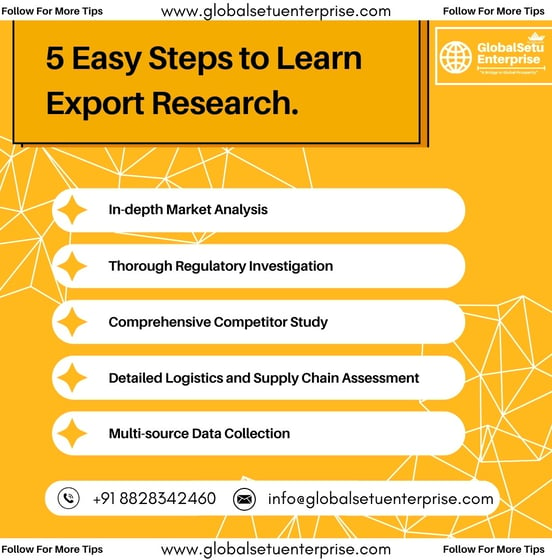
5 Easy Steps to Learn Export Research
GlobalSetu Enterprise[V.S.V]
6/6/20252 min read


Deep Dive Into Export Research: Your Guide to Global Trade Success
Exporting opens up a world of opportunities, but success in international trade begins with thorough research. Whether you’re just starting or looking to expand your existing export business, understanding every aspect—from market trends to regulatory requirements—is key. In this guide, we’ll break down five critical areas to focus on for a strong export strategy.
1. In-depth Market Analysis
Instead of merely choosing a country at random, invest the time to study detailed market reports and consumer behavior patterns in your target region. Look into demand forecasts available through government data and trade publications. This deep analysis helps you understand which products are in high demand and why, ensuring that you select the right market for your offerings.
2. Thorough Regulatory Investigation
Exporting involves more than just sending products overseas. Dive into the legal side by reviewing documents like certifications, compliance checklists, and other legal requirements for both your country and the target market. Contact trade commissions or local chambers of commerce if you need clarifications on duties, taxes, or required documentation. This ensures you remain compliant and avoid potential legal roadblocks.
3. Comprehensive Competitor Study
Learning from those who have successfully navigated export markets can provide valuable insights. Look into the strategies of established exporters in your niche—examine their pricing, marketing approaches, and distribution channels. Studying case studies or interviews can reveal common challenges and the creative solutions implemented by successful businesses, offering a practical roadmap for your own strategy.
4. Detailed Logistics and Supply Chain Assessment
Shipping products internationally can be complex, so it pays to do your homework. Research various shipping methods, compare insurance options, and explore potential outsourcing partners. Evaluate factors such as shipping costs, transit times, and any potential risks. This detailed logistics and supply chain assessment will help you find the most efficient and cost-effective way to get your product to market.
5. Multi-source Data Collection
Never rely on a single source for your export research. Combine insights from online resources, trade associations, government websites, and expert consultations. Cross-check your findings to verify accuracy and build a robust export strategy. This approach minimizes risk and ensures your decisions are backed by reliable and diverse information.
Conclusion
A successful export strategy is built on meticulous research in every aspect of international trade. By conducting an in-depth market analysis, thoroughly investigating regulations, studying competent competitors, assessing logistics, and gathering data from multiple sources, you lay a strong foundation for your global trade journey. Use these steps to navigate the complexities of exporting and steer your business toward sustained success.
GlobalSetu Enterprise
"A Bridge to Global Prosperity"
Mumbai, Maharashtra, India
We’re Here to Help! At GlobalSetu Enterprise, we value communication and collaboration. Whether you have questions about our products and services, want to discuss business opportunities, or simply wish to say hello don’t hesitate to reach out!